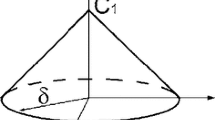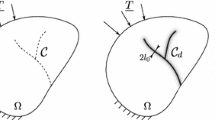Summary
A branching model for crack propagation is proposed, a ‘branch’ corresponding to an existing microfissure or flaw in the material, and the propagation of the crack to the coalescence of such branches. Increase in external stress increases the probability that a given branch will link into more than a specified number of further branches. Such increases can continue until a critical state is reached when the mean number of branches linking into a given branch is equal to unity; beyond this point, the system becomes unstable, and any slight movement is likely to lead to catastrophic rupture. The distribution of the sums of the lengths of the branches linked together in a cracking episode is investigated, and shown to lead, in the critical case, to a Gutenberg-Richter type relation with parameterb=0.75. Departures from this value are attributed to the influence of the distribution of the lengths of preexisting fissures, this distribution varying with the strength of the material and its stress history. Some difficulties with the theoretical model of Scholz are raised, and it is suggested that a more complete analysis of Scholz's model should lead to results qualitatively similar to those obtained for the branching model.
Similar content being viewed by others
References
W. F. Brace andE. G. Bombolakis (1963),A note on brittle crack growth in compression, J. Geophys. Research68, 3709–3713.
W. F. Brace, B. W. Paulding, andC. H. Scholz (1966),Dilatancy in the fracture of crystalline rocks, J. Geophys. Research71, 3939.
H. Cramer andM. R. Leadbetter (1967),Stationary and Related Stochastic Processes, New York (Wiley).
W. Feller (1966),An Introduction to Probability Theory and Its Applications, Vol. 2, New York (Wiley).
J. M. Hammersley andJ. R. Broadbent (1957),Percolation Processes: I Crystals and Mazes: II The Connective Constant, Proc. Camb. Phil. Soc.53, 269 and 642.
T. E. Harris (1963),The Theory of Branching Processes, Berlin (Springer).
E. Hoek andZ. T. Bieniawski (1965)Brittle fracture propagation in rock fracture under compression, Int. J. Fracture Mech.1, 137–155.
C. H. Scholz (1968a),The frequency-magnitude relation of microfracturing in rock and its relation to earthquakes, Bull. Seismol. Soc. America58, 379–415.
C. H. Scholz (1968b),Microfracturing and inelastic deformation of rock in compression, J. Geophys. Research73, 1417–1432.
D. Vere-Jones (1974),Stochastic models for earthquake sequences, Proc. 10th Int. Symp. on Mathematical Geophysics (to appear in Geophys. J. Roy. Astr. Soc.42).
Author information
Authors and Affiliations
Rights and permissions
About this article
Cite this article
Vere-Jones, D. A branching model for crack propagation. PAGEOPH 114, 711–725 (1976). https://doi.org/10.1007/BF00875663
Received:
Issue Date:
DOI: https://doi.org/10.1007/BF00875663




